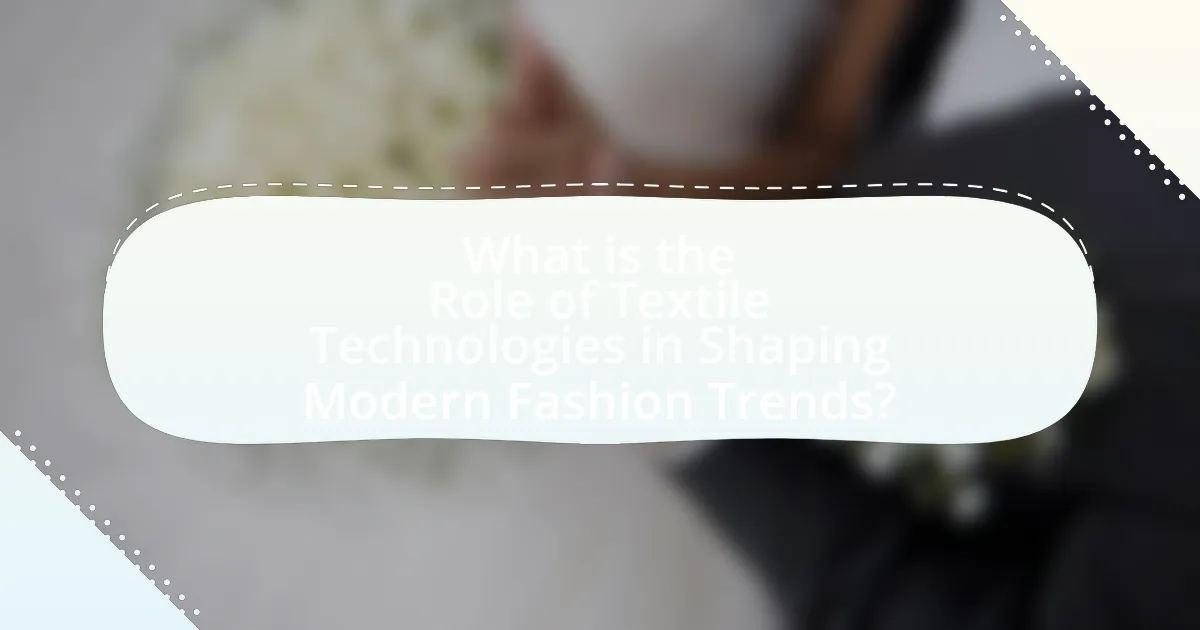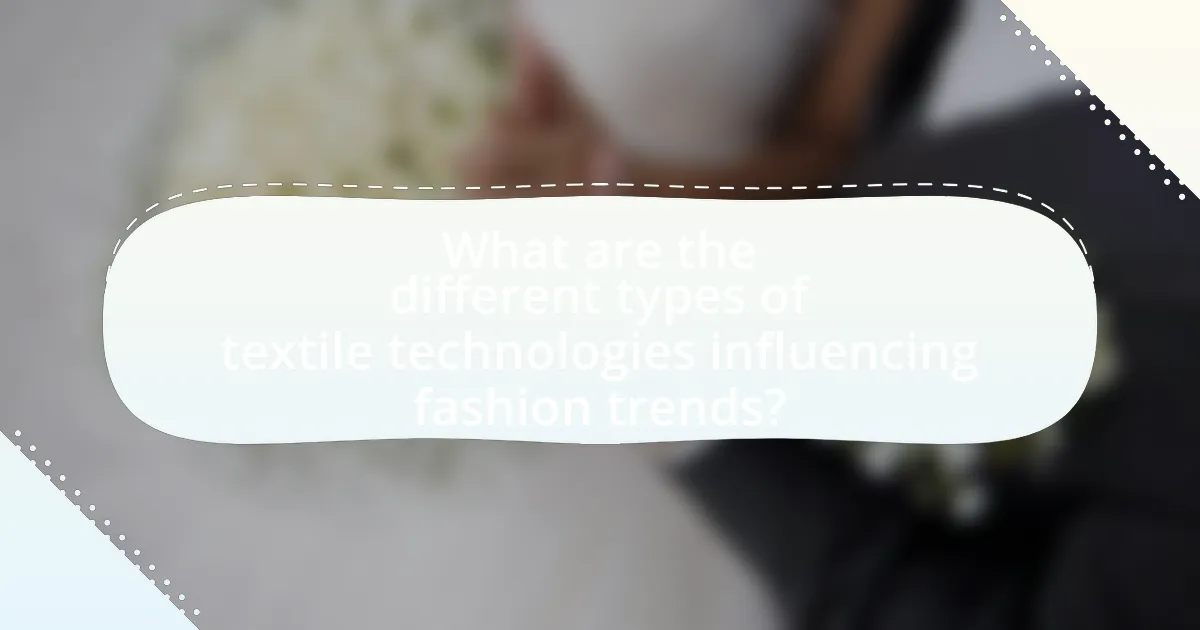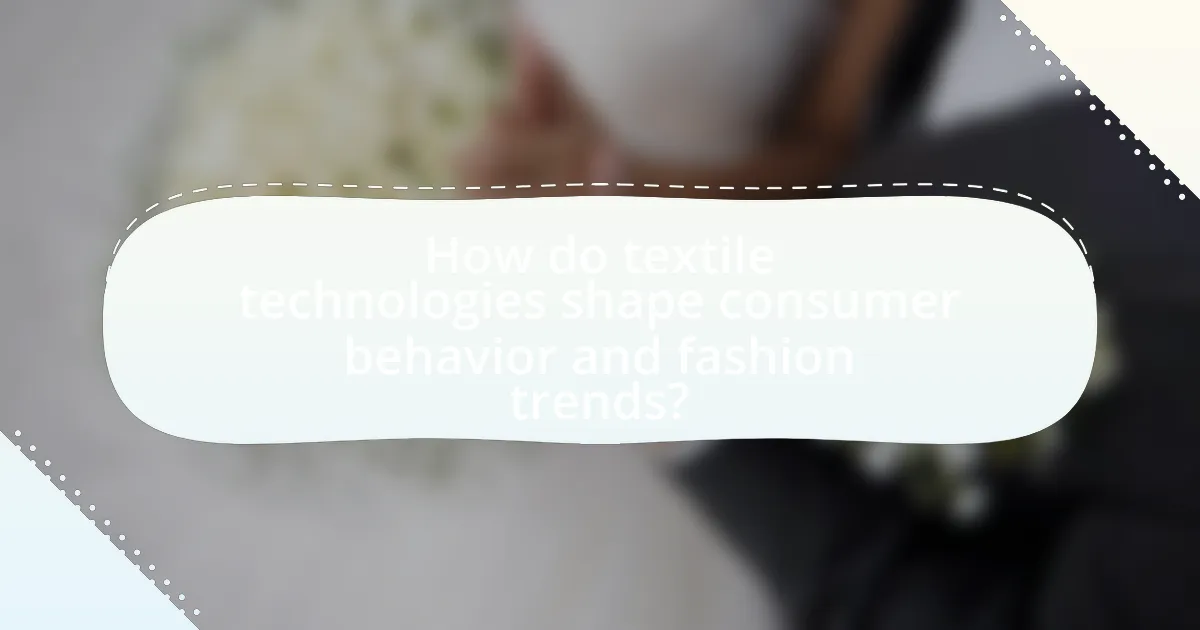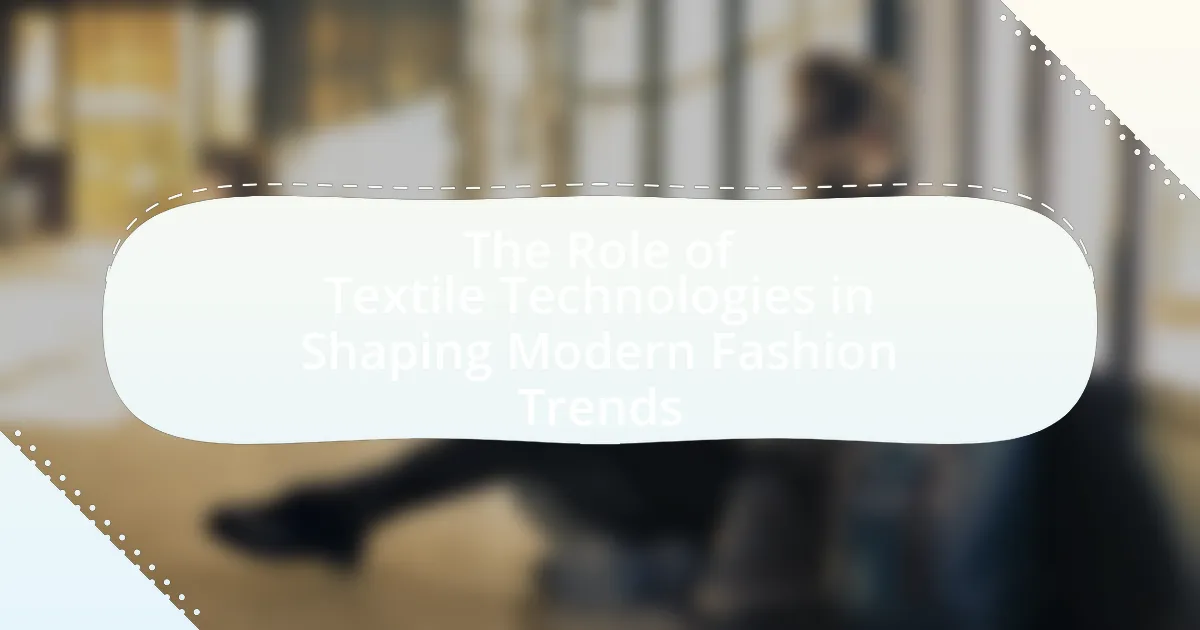Textile technologies are pivotal in shaping modern fashion trends by introducing innovative materials and production techniques that enhance functionality, sustainability, and design. Key advancements include smart textiles, sustainable materials, and automated manufacturing processes, which have evolved from traditional methods to meet contemporary consumer demands. The article explores the evolution of textile technologies, their impact on fashion design, and their role in promoting sustainability, highlighting how these innovations influence consumer behavior and market trends. Additionally, it discusses strategies for fashion brands to leverage these technologies for competitive advantage and effectively communicate their benefits to consumers.

What is the Role of Textile Technologies in Shaping Modern Fashion Trends?
Textile technologies play a crucial role in shaping modern fashion trends by enabling innovative materials and production techniques that enhance functionality, sustainability, and design. Advanced textile technologies, such as 3D knitting, smart fabrics, and eco-friendly materials, allow designers to create garments that are not only aesthetically appealing but also responsive to consumer needs, such as comfort and environmental impact. For instance, the use of recycled polyester in fashion has increased significantly, with brands like Patagonia leading the way, demonstrating a commitment to sustainability while meeting consumer demand for eco-conscious products. Additionally, the integration of wearable technology into textiles, such as fitness tracking fabrics, reflects a growing trend towards merging fashion with functionality, further influencing modern fashion trends.
How have textile technologies evolved over time?
Textile technologies have evolved significantly from manual weaving techniques to advanced automated processes. Initially, textiles were produced using handlooms and natural fibers, which limited production speed and variety. The Industrial Revolution introduced mechanized looms and spinning machines, drastically increasing efficiency and enabling mass production. In the 20th century, synthetic fibers like polyester and nylon emerged, revolutionizing the industry by offering durability and versatility. Recent advancements include digital printing, smart textiles, and sustainable practices, reflecting a shift towards innovation and environmental consciousness in fashion. These developments have not only transformed production methods but also influenced design aesthetics and consumer preferences in modern fashion.
What are the key innovations in textile technologies?
Key innovations in textile technologies include the development of smart textiles, sustainable materials, and advanced manufacturing techniques. Smart textiles, such as those embedded with sensors, enable functionalities like temperature regulation and health monitoring. Sustainable materials, including organic cotton and recycled polyester, address environmental concerns by reducing waste and resource consumption. Advanced manufacturing techniques, such as 3D knitting and digital printing, enhance customization and reduce production time, allowing for more efficient and innovative designs in the fashion industry. These innovations are transforming how textiles are produced and utilized, significantly impacting modern fashion trends.
How have these innovations influenced fashion design?
Innovations in textile technologies have significantly influenced fashion design by enabling the creation of new materials and enhancing functionality. For instance, advancements such as moisture-wicking fabrics and stretchable textiles have allowed designers to create garments that offer improved comfort and performance, catering to the demands of active lifestyles. Additionally, the introduction of sustainable materials, like recycled polyester and organic cotton, has prompted a shift towards eco-friendly fashion, influencing design choices to prioritize sustainability. These innovations have not only expanded the creative possibilities for designers but have also reshaped consumer expectations, leading to a greater emphasis on both aesthetics and functionality in modern fashion.
Why are textile technologies important in the fashion industry?
Textile technologies are crucial in the fashion industry because they enable innovation in fabric production, enhance functionality, and improve sustainability. These technologies allow for the creation of advanced materials that can be lightweight, moisture-wicking, or even self-cleaning, which meet the evolving demands of consumers. For instance, the development of synthetic fibers like polyester and nylon has revolutionized garment durability and performance. Additionally, advancements in textile recycling technologies contribute to reducing waste, aligning with the industry’s growing focus on sustainability. According to the Ellen MacArthur Foundation, the fashion industry could reduce its environmental impact by 30% through the adoption of circular textile technologies.
What impact do textile technologies have on sustainability in fashion?
Textile technologies significantly enhance sustainability in fashion by enabling the development of eco-friendly materials and efficient production processes. Innovations such as bio-based fibers, recycled textiles, and waterless dyeing techniques reduce environmental impact, minimizing waste and resource consumption. For instance, the use of recycled polyester can save up to 60% energy compared to virgin polyester production, while waterless dyeing methods can cut water usage by up to 90%. These advancements not only lower carbon footprints but also promote circular economy practices, encouraging the reuse and recycling of materials within the fashion industry.
How do textile technologies enhance functionality in clothing?
Textile technologies enhance functionality in clothing by integrating advanced materials and processes that improve performance characteristics such as moisture management, breathability, and durability. For instance, moisture-wicking fabrics draw sweat away from the body, keeping the wearer dry and comfortable during physical activities. Additionally, technologies like 3D knitting allow for seamless construction, reducing chafing and enhancing fit. Research indicates that the global market for smart textiles, which incorporate electronic components for added functionality, is projected to reach $5.3 billion by 2024, highlighting the growing importance of these innovations in modern apparel.

What are the different types of textile technologies influencing fashion trends?
Different types of textile technologies influencing fashion trends include smart textiles, sustainable fabrics, and 3D knitting technologies. Smart textiles, which integrate electronic components, allow for interactive clothing that can monitor health or change color, significantly impacting consumer preferences. Sustainable fabrics, such as those made from recycled materials or organic fibers, are increasingly favored due to growing environmental awareness among consumers, with the global sustainable fashion market projected to reach $8.25 billion by 2023. 3D knitting technologies enable the production of complex designs with minimal waste, aligning with the trend towards customization and efficiency in fashion production. These technologies collectively shape modern fashion by enhancing functionality, promoting sustainability, and enabling innovative design.
How does smart textile technology affect modern fashion?
Smart textile technology significantly impacts modern fashion by integrating functionality and aesthetics, allowing garments to respond to environmental stimuli. This technology enables features such as temperature regulation, moisture management, and even health monitoring through embedded sensors. For instance, companies like Wearable X have developed smart yoga pants that provide real-time feedback on posture, demonstrating how smart textiles enhance user experience and performance. Additionally, the global smart textiles market is projected to reach $5.3 billion by 2024, indicating a growing trend in the fashion industry towards innovative, tech-driven solutions that cater to consumer demands for both style and utility.
What are the applications of smart textiles in everyday wear?
Smart textiles are integrated into everyday wear to enhance functionality and user experience. These textiles can monitor health metrics, such as heart rate and body temperature, through embedded sensors, providing real-time data to users. Additionally, smart textiles can adapt to environmental conditions, offering features like temperature regulation and moisture management. For instance, fabrics that change their properties based on humidity levels can keep the wearer comfortable in varying climates. Furthermore, smart textiles are used in sportswear to improve performance by providing muscle support and reducing fatigue. The incorporation of these technologies into clothing is supported by advancements in materials science and electronics, making them increasingly accessible and practical for daily use.
How do smart textiles integrate with wearable technology?
Smart textiles integrate with wearable technology by embedding sensors and electronics within the fabric, enabling real-time data collection and interaction. These textiles can monitor physiological parameters such as heart rate, temperature, and movement, which are then processed by wearable devices like smartwatches or fitness trackers. For instance, a study published in the journal “Advanced Functional Materials” demonstrates that conductive fibers can transmit data from the textile to a connected device, enhancing user experience and functionality. This integration allows for seamless communication between the textile and wearable technology, facilitating applications in health monitoring, sports performance, and personalized fashion.
What role does sustainable textile technology play in fashion?
Sustainable textile technology plays a crucial role in fashion by reducing environmental impact and promoting ethical practices. This technology enables the development of materials that are biodegradable, recyclable, and produced with minimal water and energy consumption. For instance, innovations such as organic cotton, recycled polyester, and bio-based fabrics significantly lower carbon emissions and waste compared to conventional textiles. According to a report by the Ellen MacArthur Foundation, transitioning to a circular economy in fashion could reduce greenhouse gas emissions by 44% by 2030. Thus, sustainable textile technology not only addresses ecological concerns but also aligns with consumer demand for responsible fashion choices.
What are the benefits of using eco-friendly materials in fashion?
Using eco-friendly materials in fashion reduces environmental impact and promotes sustainability. These materials often require less water and energy to produce, leading to lower carbon emissions. For instance, organic cotton uses 91% less water than conventional cotton, significantly conserving this vital resource. Additionally, eco-friendly materials often involve biodegradable or recyclable components, which help minimize waste in landfills. The use of such materials can also enhance brand reputation, as consumers increasingly prefer sustainable options; a 2021 survey indicated that 66% of global consumers are willing to pay more for sustainable brands. Thus, adopting eco-friendly materials not only benefits the environment but also aligns with consumer preferences, driving market growth.
How do sustainable practices in textile technology influence consumer choices?
Sustainable practices in textile technology significantly influence consumer choices by increasing demand for eco-friendly products. Consumers are increasingly aware of environmental issues, leading to a preference for brands that adopt sustainable practices, such as using organic materials and reducing water consumption. For instance, a 2021 survey by McKinsey found that 67% of consumers consider sustainability when making a purchase, indicating a strong correlation between sustainable practices and consumer behavior. This shift in consumer preferences drives brands to innovate and adopt sustainable technologies, further reinforcing the trend towards environmentally responsible fashion.

How do textile technologies shape consumer behavior and fashion trends?
Textile technologies significantly influence consumer behavior and fashion trends by enabling innovative materials and production methods that enhance functionality and sustainability. For instance, advancements such as moisture-wicking fabrics and smart textiles cater to consumers’ demand for performance and comfort, leading to increased interest in athleisure and activewear. Additionally, the rise of sustainable textile technologies, like organic cotton and recycled polyester, aligns with the growing consumer preference for eco-friendly products, driving trends towards sustainable fashion. According to a 2021 McKinsey report, 67% of consumers consider sustainability when making a purchase, highlighting the direct impact of textile innovations on consumer choices and market trends.
What trends are emerging from advancements in textile technologies?
Emerging trends from advancements in textile technologies include the development of sustainable materials, smart textiles, and enhanced manufacturing processes. Sustainable materials, such as bio-based fibers and recycled fabrics, are gaining traction as consumers demand eco-friendly options, with the global sustainable textile market projected to reach $8.25 billion by 2027. Smart textiles, which integrate electronics for functionalities like temperature regulation and health monitoring, are becoming increasingly popular, with the smart textiles market expected to grow at a CAGR of 27.5% from 2020 to 2027. Additionally, advancements in manufacturing processes, such as 3D knitting and digital printing, are enabling more efficient production and customization, reducing waste and lead times in the fashion industry.
How do these trends reflect societal changes and consumer preferences?
Textile technology trends reflect societal changes and consumer preferences by emphasizing sustainability, personalization, and digital integration. The growing demand for eco-friendly materials indicates a societal shift towards environmental consciousness, with 66% of consumers willing to pay more for sustainable brands, according to a 2021 McKinsey report. Additionally, advancements in customization technologies, such as 3D printing, cater to consumer desires for unique products, highlighting a preference for individuality in fashion. Furthermore, the integration of digital technologies, like augmented reality in shopping experiences, aligns with the increasing consumer expectation for convenience and innovation in retail. These trends collectively illustrate how evolving consumer values and technological advancements shape the modern fashion landscape.
What role does social media play in promoting these trends?
Social media plays a crucial role in promoting trends in modern fashion by providing a platform for instant sharing and widespread visibility. It enables designers, brands, and influencers to showcase new textile technologies and fashion innovations to a global audience, facilitating rapid dissemination of ideas and styles. For instance, platforms like Instagram and TikTok have become essential for fashion marketing, with 54% of consumers stating they use social media to discover new brands, according to a 2021 survey by Statista. This immediate access allows trends to gain momentum quickly, influencing consumer behavior and shaping market demands.
How can fashion brands leverage textile technologies for competitive advantage?
Fashion brands can leverage textile technologies for competitive advantage by adopting innovative materials and production techniques that enhance product performance and sustainability. For instance, brands can utilize smart textiles that incorporate sensors for functionality, such as moisture-wicking or temperature regulation, which meet consumer demands for performance wear. Additionally, the use of sustainable materials, like recycled fibers or bio-fabricated textiles, can appeal to environmentally conscious consumers, thereby differentiating brands in a crowded market. According to a report by McKinsey & Company, 66% of consumers are willing to pay more for sustainable brands, highlighting the market potential for brands that effectively integrate textile technologies focused on sustainability.
What strategies can brands adopt to incorporate new textile technologies?
Brands can adopt several strategies to incorporate new textile technologies effectively. First, they should invest in research and development to explore innovative materials, such as bio-fabricated textiles or smart fabrics that enhance functionality. For instance, companies like Adidas have utilized recycled ocean plastics in their Parley collection, demonstrating a commitment to sustainability while leveraging new textile technology.
Second, brands can collaborate with technology firms and textile innovators to gain access to cutting-edge advancements. Partnerships with organizations like the Massachusetts Institute of Technology (MIT) have led to breakthroughs in wearable technology, allowing brands to integrate features like temperature regulation and moisture-wicking into their products.
Third, brands should focus on consumer education and marketing to highlight the benefits of these new technologies, thereby increasing consumer demand. For example, Patagonia effectively communicates the environmental benefits of its innovative materials, which resonates with eco-conscious consumers.
Lastly, brands can implement agile supply chain practices to quickly adapt to new textile technologies, ensuring they remain competitive in a rapidly evolving market. By adopting these strategies, brands can successfully integrate new textile technologies and enhance their product offerings.
How can brands effectively communicate the benefits of textile innovations to consumers?
Brands can effectively communicate the benefits of textile innovations to consumers by utilizing clear messaging that highlights specific advantages such as sustainability, durability, and comfort. For instance, brands can showcase eco-friendly materials that reduce environmental impact, supported by data indicating that sustainable textiles can lower carbon footprints by up to 30%. Additionally, brands can leverage social media platforms to share testimonials and visual content demonstrating the performance of innovative textiles, which can enhance consumer trust and engagement. Research from the Textile Institute shows that consumers are increasingly influenced by transparency regarding material sourcing and production processes, making it crucial for brands to provide detailed information about their textile innovations.
What are some best practices for integrating textile technologies in fashion design?
Best practices for integrating textile technologies in fashion design include adopting sustainable materials, utilizing digital design tools, and implementing smart textiles. Sustainable materials, such as organic cotton or recycled polyester, reduce environmental impact and appeal to eco-conscious consumers. Digital design tools, like 3D modeling software, enhance creativity and streamline the design process, allowing for rapid prototyping and adjustments. Smart textiles, which incorporate technology for functionalities like temperature regulation or moisture management, offer innovative solutions that meet modern consumer demands. These practices are supported by industry trends emphasizing sustainability and technological advancement, as evidenced by the growing market for eco-friendly fashion, projected to reach $8.25 billion by 2027, according to a report by Grand View Research.

Leave a Reply